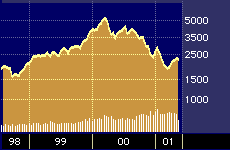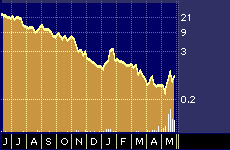
Envision the Tech Rebound
Envision the Tech Rebound
By Hal Plotkin
CNBC.com Silicon Valley Correspondent
Jun 6, 2001 04:23 PM
For months now, most tech stock analysts have been roughly divided into two camps, those who expect to see a rapid V-shaped recovery in stock prices, which some think has already started, and those looking for a slower U-shaped recovery that extends into early next year.
Tech investors should add the much less promising L-shaped option to that list.
An L-shaped recovery would disappoint tech investors hoping for a sustained bounce off the sector’s much sought-after trading bottom. Instead, investors getting in at the bottom might just stay there, at least for a while.

Nasdaq Composite 3-year index performance
“The likelihood is that the tech stock decline is foreshadowing a multiyear downturn in capital spending,” warns Steve Milunovich, global technology strategist at Merrill Lynch, in a sector update published this week. “Capital spending and tech stock performance are closely correlated. The upcycle was eight years, the downside should be at least two years.”
In recent days investors have reacted favorably to signs that the worst may be over for tech stocks. But several analysts note that the tech industry lacks the drivers needed to significantly boost end-user demand and growth after the sector hits bottom, particularly when it comes to new products.
The tech boom of the last few decades was supported by rapid growth in a dazzling array of new product categories that proved hugely popular with end-users. Most of these new markets were created virtually from scratch. There were personal computers, cell phones, color printers, pagers, computer servers, digital storage devices, and laptop computers, to name but a few of the new product categories that came out of nowhere to mushroom into multi-billion dollar markets over the past few decades.
So what’s on the horizon that will get the tech juggernaut rolling again?
Not much. At least not over the next few quarters, which is a period when many analysts and investors appear to be banking on a tech stock recovery.
“All you are going to get out of the next two quarters is a recovery from a depressed point in capital expenditures and some seasonal growth,” says Michael Murphy, editor of the California Technology Stock Newsletter. “Beyond that there is no real driver that soon. Towards the end of 2002, though, you get Windows XP Itanium systems getting very cheap, under $1000, and another big replacement cycle. And there is the question of what happens overseas, in Asia and Europe, where they are way behind in deploying new stuff.”
Murphy holds out hope for tech stocks. But like most other experts, he has a hard time coming up with examples of any specific new products, or even product categories, that could give the sector anything like the type of end-user demand lift it got from the first big wave of digital wares.
Recently, many growth-minded investors have been banking on promises of a rapid rollout of broadband Internet and wireless services, which theoretically would support an as yet not invented new generation of consumer and business computing and entertainment devices. But the recent failure of many competitive local exchange carriers, lagging installations of next generation wireless services, and the painfully slow deployment of broadband to the home appear to be dashing those hopes, at least for the foreseeable future.
In Silicon Valley, for example, the most expensive wireless connection speeds currently offered top out at about 128Kbps, a speed that was available more than five years ago for desktop users. Most current wireless Internet users, however, are still slogging away at or under a glacially slow 27 Kbps, which is a speed that was available on desktops during the Reagan administration. The experts now say it will be at least another two to three years before the next generation of wireless technologies, called 3G, becomes widely available to consumers in the U.S.
Likewise, the rollout of broadband connections, particularly to the home, has been a similar disappointment. Know anyone who has downloaded any full-length motion pictures lately? Not likely.

iBEAM Broadcasting Corp. 52-week stock performance
Stocks of companies such as iBEAM Broadcasting Corp. {IBEM, News, Boards}, which focuses on enhancing the delivery of streaming media, have been decimated by the slow penetration of broadband Internet services. The most notorious example, though, might be Quokka Sports Inc. {QKKA, News, Boards}, a firm that blew through more than $75 million dollars in an ambitious scheme to provide Internet-based sports broadcasting. The company suspended operations last month.
The obvious conclusion is that it’s unlikely popular new broadband-based tech products will emerge anytime soon, not when so many of those currently trying to crack open that market are having so little luck.
“We are probably living in the most innovative time in history,” says Malcolm Brown, a portfolio manager at Fiduciary Trust International, based in New York. “But the 1998-2000 euphoria was an aberration. Expectations of 20 to 25 percent [annual] growth are not realistic. There are years when it might be. But tech is very volatile, to both the upside and the downside.”
As a general rule, Brown says he’s telling his clients to stay on the tech sidelines for the time being, although he says he does look for selective opportunities to invest in the strongest tech names.
“We do think that the long-term looks good, but there are a lot of short-term issues that need to be worked out,” he says.
Like Brown, few if any experts think technology companies have reached the limits of their potential when it comes to introducing revolutionary new, must-have gadgets and services.
“Technology enables dramatic new products,” says Murphy, of the California Technology Stock Newsletter. “People didn’t know they needed email and now everyone has it. I think we’re going to see the creation of new products and services that people aren’t even thinking of today. Until that happens, though, people can be pretty unimaginative.”
Nonetheless, there is a growing sense among many experts that the tech sector could now be in the beginning rather than the closing stages of a growth pause, the duration of which will largely depend less on further interest rate reductions and more on the creativity of those working to bring new products to market and slowly developing improvements in the telecommunications infrastructure.
“In terms of the product cycle, it’s going to be a slower appreciation in tech stocks,” says money manager Brown.
As such, trying to time the bottom of what turns out to be an L-shaped recovery might not be such a clever idea after all.


